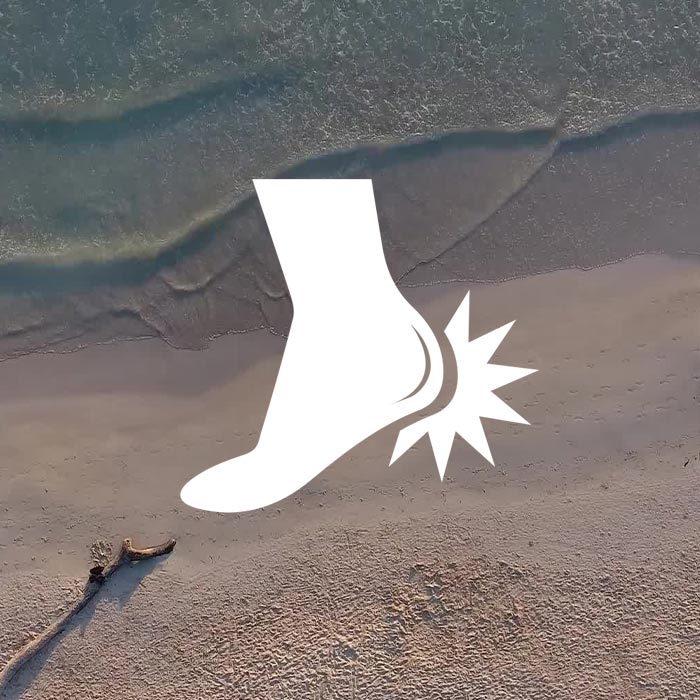The achilles tendon is the strongest tendon in the body. It gives us a spring in our step, connecting the calf to the heel bone. Achilles tendonitis is a dynamic that emerges from an interplay between tightness and inflammation of muscle and connective tissue. Inflammation causes pain, which causes the tendons to tighten, causing further inflammation. Once the cycle of pain begins, achilles tendonitis will stick around until you do something about it!
Symptoms
- Swelling, warmth & redness in the back of your lower leg
- Pain in back of ankle two inches above the heel
- Noticeable pain after stretching the calves
Prevention
Achilles tendonitis can be cause by overuse from long distance running, excessive rolling of the foot inward, flat feet, and tight calf muscles. Here are some ways to avoid it.
Exercise
⭐︎⭐︎⭐︎⭐︎
Heel lifts and calf stretches will prevent most occurrences of Achilles Tendonitis.
Rest
︎⭐︎⭐︎⭐︎⭐︎
It’s important to get at least 7 hours of sleep every day. If you are feeling sluggish in the daytime, a 20 minute nap will give you just enough rest without releasing melatonin into your system and making you drowsy.
Proper footwear
⭐⭐︎⭐︎⭐︎⭐︎
Athletic shoes with at least a one inch heel keep the feet sufficiently elevated to prevent injury. This is essential for weight training and running.
Magnesium
⭐⭐︎⭐︎⭐︎⭐︎
More than 300 of the body’s enzymes require magnesium to drive catalytic action, especially ATP, or adenosine triphosphate, the “molecular unit of currency” of intracellular energy transfer. Translation: this essential mineral should be in the utility belt of any would-be athlete. Eat green, leafy vegetables, or take it in supplement form to prevent neuromuscular, cardiovascular, and metabolic dysfunction.
Reduce or quit nightshades
⭐⭐⭐︎
Numerous studies have proven the value of eating tomatoes, peppers, eggplants, and potatoes as part of a balanced meal, but eating too many can cause inflammation and bone spurs, which can cause Achilles Tendonitis.
Recovery
Once you get it, it’s important to know how to prevent it from happening again, so if you have achilles tendonitis and skipped to this section, check out the steps for prevention above. If this is the first day of the injury, go get some ice for your heel, we’ll wait.
Night splint
⭐⭐︎⭐︎⭐︎
These handy splints stretch the tendons and ligaments in the foot, ankle, and calve as you sleep. Overnight pronation prevents that soreness you may feel as soon as you get out of bed, but it’s also been show to reduce inflammation, keeping the condition from worsening. This is a great supplemental option to good shoes with proper exercise and diet.
Trigger point therapy
⭐⭐︎⭐︎⭐︎
Place your calf over your knee and push it into the knee. You will feel tender spots that can be rubbed out. Once you’ve located and addressed as many points as your knee can target, put both thumbs together and push them into the tender spots and massage the sore points.
Massage the lesion
⭐⭐︎⭐︎⭐︎⭐
Locate the lesion, which will be on the side of tendon. Pinch both sides of the tendon, right above the heel, and apply pressure. Begin massaging the region. After 5-10 minutes, you should feel the scar tissue realigning with the tendon. It may go numb, or even feel good. If it starts hurting too much, stop and ice it.
Stretch
︎⭐︎⭐︎⭐
Stretch by straightening your leg and using a belt to pull the foot toward you. Don’t stretch for more than 30 seconds at a time. Secondly, push against a wall with your injured foot extended and your other leg bent at the knee. For best results, do this in tandem with other techniques.
Want more articles like this? Leave a rating!
- Readers Rating
-
Rated 5 stars
5 / 5 ( Reviewers) - Spectacular
- Your Rating
-




